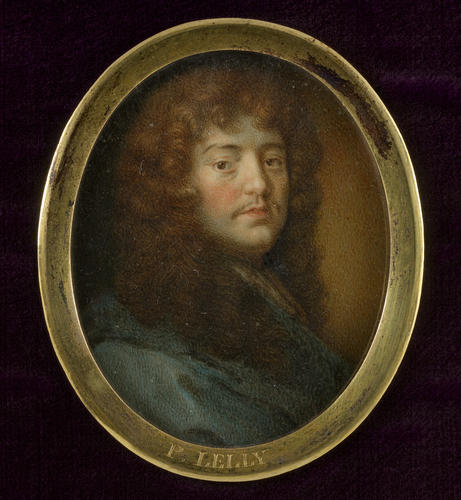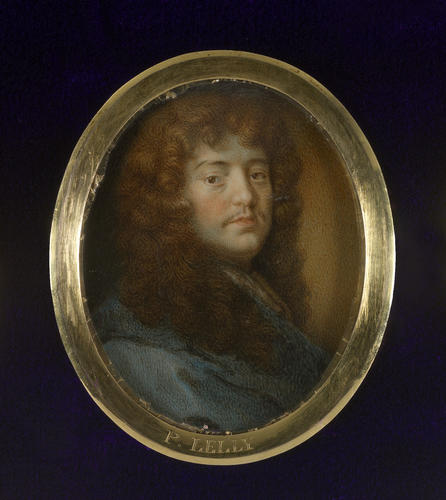Giuseppe Macpherson (1726-c. 1780)
Sir Peter Lely (1618-1680) c.1772-80
6.8 x 5.2 cm (sight) | RCIN 421318
-
Sir Peter Lely was a painter of Dutch origin who spent almost all his career in England and was naturalised in 1662. His family name was van der Faes and the name Lely is said to have come from the lily carved on the house where his father was born in The Hague. He trained in Haarlem and moved to England in the early 1640s. With the death of Sir Anthony van Dyck in 1641 and of William Dobson in 1646, he became the leading portraitist, described by a contemporary as 'the best artist in England'. Lely is most closely associated with the court of King Charles II, but he also painted Charles I and his children and Oliver Cromwell and his son Richard. He was made principal painter to the king in 1661, enjoyed an extravagant lifestyle, and was described by the diarist Samuel Pepys as 'a mighty proud man, and full of state'. Amongst Lely's portraits were the 'Windsor Beauties', a set of eleven portraits of celebrated women at the Restoration court, commissioned around 1662-5 and now in the Royal Collection. Pepys recorded on 21 August 1668 that he 'did first see the Duke of York's room of pictures of some Maids of Honour, done by Lilly: good, but not like.' Pepys was alluding to the view that Lely flattered his subjects, giving each portrait a similar languorous and 'sleepy eyed' air.
This miniature is one of the collection of copies of 224 self-portraits by artists in the Uffizi Palace, Florence, that Lord Cowper, the art collector and patron, commissioned Giuseppe Macpherson (1726-1780) to paint. He presented the miniatures to King George III in two batches, in 1773 and 1786. Macpherson followed the original self-portraits quite closely, but copied only the head and shoulders. He inscribed the artists' names on the backs of the miniatures – several differ from those in the modern Uffizi catalogue, notably: Bazzi, Bellini, Campi, Annibale Carracci, Gabbiani, Masaccio, Metsys, Moroni, Pencz, Licinio, Schiavone and Spada. None of the miniatures is signed, apart from Macpherson's own self-portrait, which is inscribed: Giuseppe Macpherson / Autore della serie (Giuseppe Macpherson / Author of the series).Macpherson was born in Florence, the son of Donald Macpherson, a footman in the service of Alexander, 2nd Duke of Gordon. He was a pupil of Pompeo Batoni and painted miniatures and enamel portraits in Italy, France and Germany, finally settling in Florence. A James Macpherson is recorded in London and Paris in 1754 but it is not certain that this is the same person. He was described in 1776 as having a special talent for painting on enamel and as being 'almost the only painter in Europe who possesses this art to perfection'. He had a distinguished client list which included some of the crowned heads and dignitaries of Europe. In 1778, he was invited to add his own self-portrait to the famous painters in the grand duke's collection as it 'would do honour to Florence to enrich the collection with a work which shows that we still have some men of true merit' according to Giuseppe Pelli, director of the Uffizi at the time.
Provenance
Presented to George III by Lord Cowper
-
Creator(s)
-
Medium and techniques
Measurements
6.8 x 5.2 cm (sight)
Category
Object type(s)











